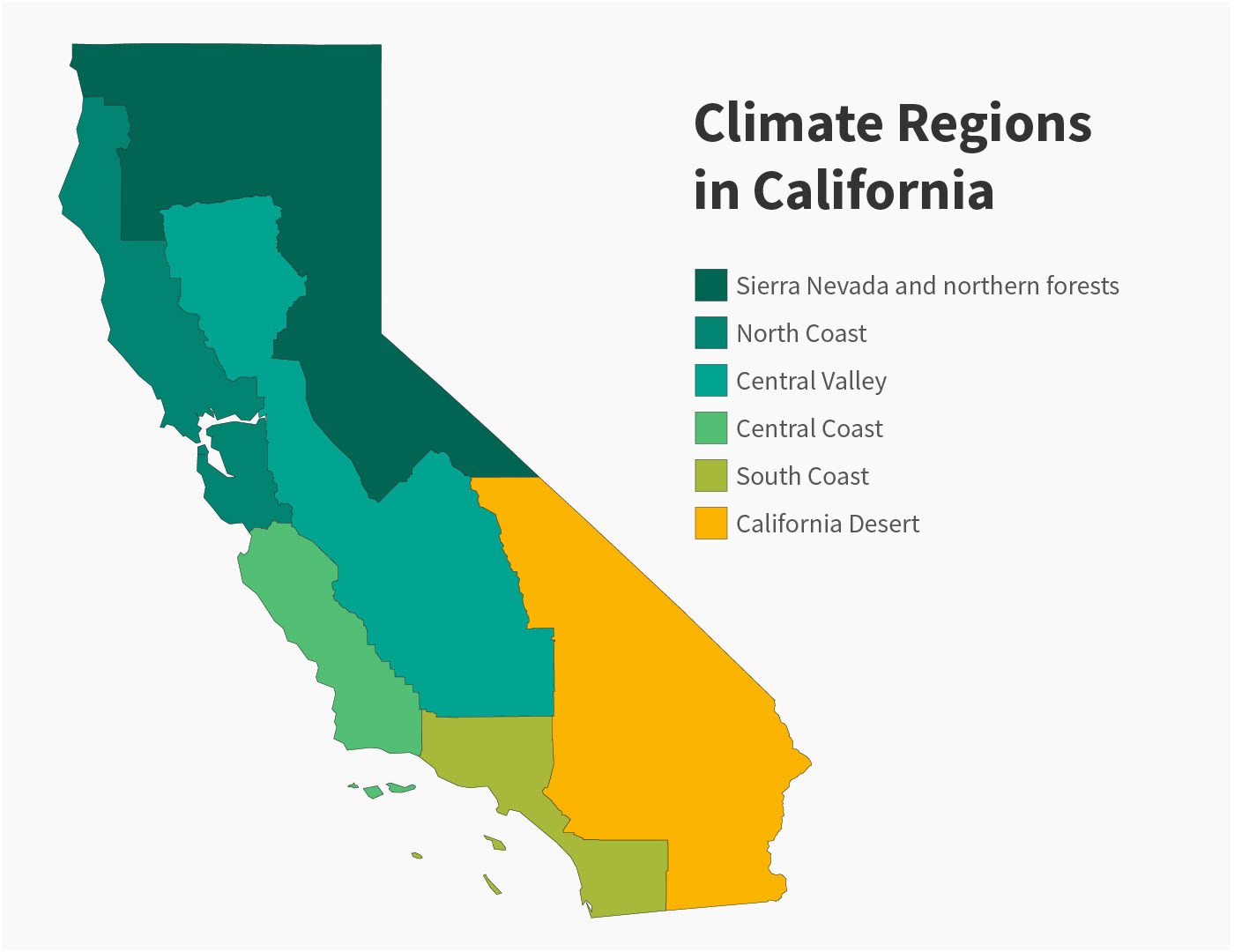Moving to California: What it’s Like to Live in the Golden State
Find Cheap Renters Insurance Quotes in Your Area
California is among the biggest states in the nation, both in terms of land size and population, so you'll find a lot of variety among regions and cities in the state. It's also one of the most expensive places to move to in America, so be prepared to spend more of your income on necessities like housing and transportation.
What is it like to live in California?

Talk to a Californian about what it's like to live there, and they'll likely call out three things first: the weather, the food and the relaxed, easygoing culture. California's location and topography mean that much of the state, especially along the coast, experiences remarkably consistent warm weather year-round.
For example, Los Angeles has sunshine an average of 263 days per year. And there are plenty of opportunities to make use of that great weather. California is home to nine national parks, including Yosemite, Sequoia and Joshua Tree. And there are many places statewide for outdoor activities, including beaches, hiking trails and more.
Great food is also readily available. California's Central Valley is a major agricultural center, so fresh produce is inexpensive and high quality. What's more, California has an array of cuisines available, due in part to its strong immigrant communities.
In fact, California is the second-most ethnically diverse state in the US and has the most immigrants, in both number and percentage of its overall population. If you live in California, you're likely to live and work with people from all walks of life.
The climate of California
California is known for having a warm, sunny climate, and that's generally accurate. However, the state has an incredibly varied geography that results in many climates.
The state has "microclimates," where temperatures can range dramatically from one place to the next, despite a short distance separating the two. For example, on a summer day, it might be 60 degrees in Palo Alto but 80 degrees in San Jose, less than 20 miles away.
In general, it can be useful to think of California as having five climate regions:
- South Coast
- North Coast
- Central Valley
- California Desert
- The mountains (Sierra Nevada and Sierra Madre) and northern forests

The coastal areas of California have the most consistent weather and are the most densely populated, with 68% of California residents living in counties along the ocean.
Generally speaking, the South Coast — with cities like San Diego and LA — is warmer, sunnier and drier than the North Coast. For example, the average summer high in Los Angeles is in the mid-80s, and the city gets about 36 rainy days per year. Meanwhile, a typical summer high in San Francisco is in the mid-60s, and the city gets about 73 days of rain annually.
The Central Valley, California's agricultural center, has more pronounced seasons than the coast. Its hot summers regularly hit the high 90s and low 100s, while winter highs hover around the mid-50s. Most Californians who don't live on the coast can be found here, in cities such as Sacramento and Fresno.
The mountains, including the Sierra Nevada and Sierra Madre, and northern forests of California are much cooler and see far more precipitation (including snow) than the rest of the state. At higher elevations, snow sometimes persists into the summer months, sometimes making it possible to go skiing in July or later. There are small towns throughout the mountain ranges, but they're far less densely populated than the coasts.
The California Deserts region, bordering Nevada, is hot and dry year-round. Death Valley, in particular, is famous for being one of the hottest places in the world, having set the record for hottest recorded temperature in history. The deserts are inhospitable to humans and sparsely populated.
Wildfires
A consequence of California's sunny weather is that the state gets less rain than most other states. A recent yearslong drought has led to wildfires being a consistent problem. Since 2000, there have been about 8,000 wildfires each year in the state.
While it's impossible to predict where a wildfire will occur, the risk is an important consideration — especially if you're buying in a drier region or a rural area where fire departments are spread thin. Some areas are at such a high risk of wildfire that insurers may not be willing to cover you, so keep that in mind before you move.
Cost of living in California
By many metrics, the cost of living in California is consistently among the highest in the nation, especially in desirable areas like San Francisco and Los Angeles. It's very difficult to find a cheap place to live here. The median value of an owner-occupied home is $573,200, which is the second-highest countrywide — beating only Hawaii. This is somewhat balanced by California's high wages, as the median household income is $84,097.
Unfortunately, renters don't fare much better. The median rent in the entire state of California is $2,950. That's almost one and a half times the national median of $2,002. California's median rent works out to be 42% of the median household income, meaning a typical Californian may be spending nearly half their salary just on housing.
Working in California
California has a strong economy, with a gross state product of $3.36 trillion. If it were a country, its gross domestic product (GDP) would be ranked fifth worldwide, putting it ahead of the United Kingdom and closing in on fourth-ranked Germany. California also boasts a diverse set of industries that contributes to its strong economy, meaning there are many types of jobs for residents.
Significant industries statewide include trade, agriculture and tourism. In southern California, including Los Angeles, notable industries include entertainment, such as movie, television and music production. The San Francisco Bay Area is known for being host to technology giants like Apple, Google and Facebook, not to mention thousands of smaller companies and startups.
The median household income is among the highest in the country, exceeding both Texas ($66,963) and New York state ($74,314), though high wages are offset by a high overall cost of living.
Getting around in California
In the vast majority of California, the dominant way to get around is by car. That means that the cost of getting around primarily involves gas, insurance and buying or leasing a car. Gas prices are very high in California: Prices in the state are currently 31% higher than the national average. This places it ahead of every other state in the country for gasoline costs, except Hawaii.
Car insurance rates in California are about average for the US. However, car insurance shoppers can frequently find a better deal by shopping around at multiple insurance companies.
Car insurance requirements in California
California does not have particularly stringent minimums for auto insurance coverage. The only requirements are liability coverage for bodily injury and property damage. You're not required to get uninsured/underinsured motorist coverage or personal injury protection. However, you should consider your own insurance needs and what level of risk you're comfortable with when buying auto insurance, not just the minimum amount necessary by law.
California Required Car Insurance Coverage | CA Required Minimums |
|---|---|
| Bodily injury (BI) liability insurance | $15,000 per person / $30,000 per accident |
| Property damage (PD) liability insurance | $5,000 per accident |
Where should I live in California?

California has an endless array of places to live, each with its own style, cost of living and job opportunities.
Moving to Los Angeles
Los Angeles is California's largest city and center point of sunny SoCal culture. The city itself is large, but the entire county is almost as big as the state of Connecticut. There are hundreds of different neighborhoods and places to live, from beachy Santa Monica to upscale Beverly Hills. But that size means it can take a long time to get anywhere, and Los Angeles's traffic is notorious. Depending on where you live, you might run into celebrities — but with a population of nearly 4 million, you'll have to keep your eyes peeled.
- Key industries: Entertainment (music, movies, television)
- Average rent for one-bedroom apartment: $2,327
- Best perks: Beaches, hiking, Disneyland
- Biggest drawbacks: Urban sprawl, traffic
Moving to San Francisco
San Francisco was long considered second fiddle to Los Angeles, but the tech booms of the late 20th and early 21st centuries have put San Francisco on equal footing with LA in terms of cultural cachet — and more expensive when it comes to the cost of living. It has famously variable weather that doesn't correspond to typical seasons. The warmest months are September and October, and temperatures can fluctuate wildly based on location and time of day. But you'll be treated to beautiful row houses, world-class restaurants and parks right in the city. It’s small size and high density mean that it's far easier to go without a car here than anywhere else in the state.
- Key industries: Technology, finance
- Average rent for one-bedroom apartment: $3,428
- Best perks: Great restaurants, no car needed
- Biggest drawback: Very high housing costs
Moving to the Bay Area (Outside San Francisco)
Given San Francisco's tiny geographic size, it's no surprise the city's culture has spread into the surrounding Bay Area, which is home to Silicon Valley and tech giants Apple, Facebook and Google. Some of the best universities in the country are also located here, including Stanford University and the University of California, Berkeley. North of San Francisco are Marin County, Napa Valley, Sonoma County and Redwood National Park.
Weather in the Bay Area is warmer than in San Francisco. Additionally, things are more spread out, so you'll likely need a car to live there. While rents are a little cheaper than in SF, they are still more expensive than a typical California apartment. The same cultural ethos also prevails. The largest city in the Bay Area, San Jose, is actually bigger than San Francisco, so SF is not your only big-city option in the region.
- Key industries: Technology, finance (similar to San Francisco)
- Average rent for one-bedroom apartment: $2,639 (in the San Jose–Sunnyvale–Santa Clara metropolitan area)
- Best perk: Plenty of green space
- Biggest drawback: Low density means you have to drive everywhere
Moving to San Diego
San Diego is California's ultimate beach town. It's the second-biggest city in the state, located in the southwestern corner, just over the border from Tijuana, Mexico. Despite its large population, it has more of a small-town feel than Los Angeles. Life in San Diego is generally very relaxed, with abundant opportunities to go to the beach year-round. The average high in July is 75°F, while in January it's just 10 degrees cooler, with an average high of 65°F. However, the city's unbeatable weather means that rents are very high.
- Key industries: Defense/military, trade, tourism, biotechnology
- Average rent for one-bedroom apartment: $2,787
- Best perks: Beaches, San Diego Zoo
- Biggest drawback: Low wages compared to housing costs
Moving to Sacramento
Sacramento is the capital of California, and with a population of around 525,000, it's the state's sixth-largest city. It's located about two hours inland by car from San Francisco, so you're missing out on the easy oceanfront access of other locales on the list, but it's a far more affordable place to live. An average rental in Sacramento is a relative bargain at $2,060 per month. There are plenty of lakes and rivers to explore in the area, so you don't need to travel far to get on the water. Plus, Sacramento puts you closer to skiing and national parks like Lake Tahoe and Yosemite.
Sacramento doesn't receive as much of a moderating effect from the ocean as coastal California, so its weather gets much hotter in summer, with highs usually reaching the low 90s. Winters are cooler, but not cold: Lows are typically in the low 50s.
- Key industries: State government, trade, agriculture, health care
- Average rent for one-bedroom apartment: $2,060
- Best perks: Easy access to national parks, affordability
- Biggest drawback: Hot summer weather
How to move to California

If you're committed to moving to California, the first thing to keep in mind is how expensive it is to do so. Most places in California are very pricey to live in, so the bigger a financial cushion you can put together, the better off you'll be. If you're able to secure a job offer before you move, even better, especially if your company can cover moving expenses.
Renting an apartment in California
California's high rents and low vacancy rates make it very challenging to rent an apartment in most places in the state. It's especially challenging in desirable locales like The Mission in San Francisco or Culver City in Los Angeles. The first step is to pick an area and an approximate price range. A good rule of thumb is to divide your annual salary by 40 and set that as the amount you should spend. It will be close to one-third of your salary.
For example, if you make $80,000 per year, you should aim to spend around $2,000 per month on rent.
The ideal strategy for locating an apartment in California is to combine looking online with hunting in person in your neighborhood of choice. You can survey a much wider area by using online tools like Craigslist and Zillow, but searching on foot or by car allows you to get a better feel for what a neighborhood is actually like. Plus, you might find a great deal for a place not listed online.
If you end up working with an apartment broker or agent, the landlord will usually pay their commission. You don't need to worry about any additional costs beyond an application fee, which may run in the $30–$50 range.
Housing considerations in California
There are some benefits and points to consider when choosing where you'd like to live in California, beyond the feel of a neighborhood.
- Building size and style: There are lots of options for housing in California, from stand-alone houses to multiunit complexes. Tall apartment buildings are relatively less common in California, but there are complexes that include amenities such as a shared pool or exercise center.
- Commute time: California traffic is consistently bad. If you can, try to pick a place that will make your commute as easy as possible, so you can spend less time in your car and less money on gas.
- Parking: Some apartments include parking as part of your rent, while others charge extra for a spot. And some places don't provide parking at all. Keep the possible extra cost of a parking spot in mind when setting your budget.
- Air conditioning: Depending on the region you live in and your own tolerance for heat, you may or may not need air conditioning. Consider whether you'd be comfortable with fans or a window unit or if you need central AC.
What to bring when looking for apartments
Once you're ready to start hunting for your apartment, prepare your paperwork and bring it with you to each showing. If you love an apartment, putting in your application immediately may boost your chances of securing the lease.
You should bring:
- Checkbook to pay the deposit
- Photo ID
- Proof of employment or pay stubs
- References
- Credit score
An individual application may not not require all of these items, but competition for apartments is fierce. If you're missing a necessary document and another applicant submits their application first, you might lose out. So it's better to come prepared.
Renters insurance
Once you move into your new California apartment, make sure to purchase a renters insurance policy. The cheapest renters insurance policies only cost a few dollars a month, and you'll be protected if your belongings are damaged or stolen. Some landlords even require you to buy renters insurance in order to move in.
Registering your car in California
If you're bringing your car with you, you'll have to register it with the California DMV within 20 days of moving to the state. Before doing so, you'll need proof of insurance, your previous title and registration and an emissions certification (unless your car is less than four years old or a hybrid/electric vehicle).
When you go to register your car, a DMV employee will perform an inspection and verify your VIN. Once you've completed all of the necessary forms and paid the appropriate fees, you'll be issued your California registration and license plates.
Editorial Note: The content of this article is based on the author’s opinions and recommendations alone. It has not been previewed, commissioned or otherwise endorsed by any of our network partners.
